What is The Digital Grid?
Concept
At the University of Tokyo, Professor Rikiya Abe’s focus is to consider solutions to the big issues which are increasingly affecting society, such as energy security, global warming and unsustainable practices.
Prior to his appointment at the university, Dr. Abe spent over 30 years as a researcher and engineer at J-Power, Japan’s nationwide wholesale electric utility. Over the past ten years, Dr. Abe began to see strong advantages to the design of the Internet, with addressable nodes, interconnectivity that increased robustness against failure, and the traceability of information across the network.
He began to develop the idea of routing power, analogous to routing data in a network. With the advent of lower cost power switching devices, the costs begin to come into an acceptable range. With this beginning, he developed the concept of the Digital Grid.
Today, messages about energy are mostly negative ones. We are focusing on ways to use less energy, even though life in the 21st century requires increasing consumption of energy, not only for the third world, but for the first world.
Not only are we required to use less energy, but the use of energy is becoming more complex and intrusive. For example, time-of-use pricing or demand response requires much more day-to-day thought than people wish to expend in a life that is already complex and overloaded with information.
In fact, there is abundant renewable energy – much more than we use or even foresee to use globally. With the Digital Grid, we envision a world where energy is abundant, and new uses for energy can resolve entrenched problems such as availability of fresh water.
We look forward to such a world, and propose the design of a Digital Grid which would support such a world.
If we can envision a future world where energy is abundant, we can also foresee new ways to use electricity that are not possible with the current grid design.
The Digital Grid concept is explained here, the grid of the future which is appropriate and necessary in a world of greater renewable energy generation. We would like to envision a digital grid where energy use enables a better world rather than being a harbinger of environmental damage.
According to the US Department of Energy, the solar energy resource from a 100-mile-square area of Nevada could supply the United States with all its electricity (about 800 gigawatts) using modestly efficient (10%) commercial PV modules ( see DOE report here ). With sufficient energy storage, solar energy could produce 100% of the energy needs of the world. Rather than restricting energy usage in the name of environmental protection, a solar powered grid would make abundant energy available for new applications and benefits. Abundant energy can also be a solution to the problem of fresh water supply, food production, liquid fuel synthesis, etc.
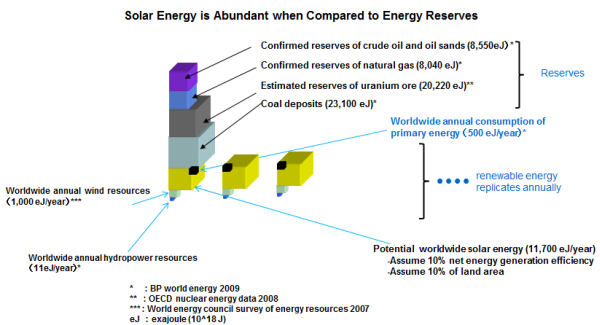
Many initiatives for resolving energy issues involve conservation of energy or energy efficiency. For example, smart grid and demand-response are both focusing on better utilization of energy. However, as the following chart shows, the growth in energy supply is mirroring global population growth. While efficiency improvements are helpful, they do not address the core issue that energy demand will not slow before population growth stops.
Global warming is generally accepted as a catastrophic problem for the world. We make the argument that renewable energy is abundant, and has the potential to completely replace the use of fossil fuels. This transition requires both energy storage as well as the Digital Grid.
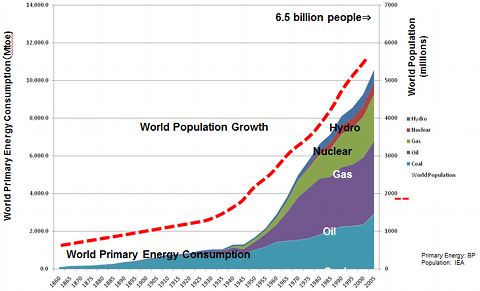
According to the DOE, a solar PV plant 100 miles square in the Southwest would generate 100% of the electricity used by the entire US today. Such a solar plant would not need to be located in only a single place, of course. This is only to illustrate the scale of solar energy which would address our energy needs.
In order to make use of solar energy for substantial proportions of our energy needs, storage will be necessary.
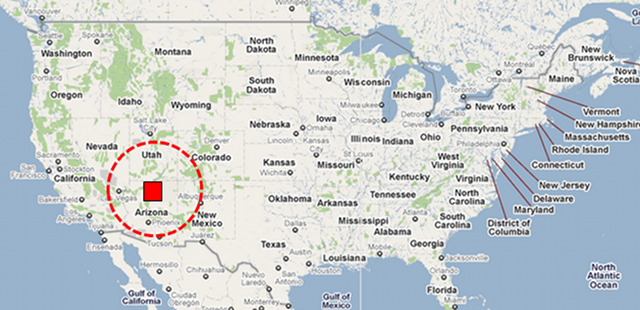
Renewables such as solar and wind, are sufficient in total average energy supply, however, due to weather conditions and diurnal variation, the supply of energy at any given instant will not meet the required energy demand. For this reason, energy storage will be required if renewable energy is to provide a large proportion of our daily demand of energy.
Energy storage is available through a variety of technologies today. The most widely used technology for bulk energy storage is pumped hydroelectric power. Many hydroelectric power plants have reservoirs below the power source, which are able to use excess energy from the grid to pump water back up to the upper reservoir. Typically, water is pumped up at night, when demand is low, and then flows back down to generate during peak energy demand hours during the day.
Compressed air is another type of energy storage, where air is compressed and stored either in tanks above ground or in unused caverns underground.
Large solar power plants are often thermal plants, which use giant movable mirrors to concentrate the energy from the sun to heat a fluid which is then used to drive steam turbines to generate electricity. These thermal solar plants are currently being built with large tanks to store the heated fluid, enabling the generation of electricity during the evening hours after the sun goes down.
Finally, there is battery technology, which is seeing both technology improvements and cost reductions driven by the growth of the electric vehicle industry.
We believe that through the mass deployment of all of these types of energy storage, the costs will drop dramatically.
The chart at the left, which is logarithmic on both axes, shows the drops in prices delivered by the photovoltaic module industry. As production rose, pricing dropped, showing a reduction of 100:1 over the 30 years from 1976.
We believe that energy storage will illustrate a similar drop in pricing as production expands up to gigawatt scales.
We would like to emphasize, however, that energy storage is not strictly required for the digital grid. Many of the benefits of the digital grid can be obtained without energy storage. Storage is necessary for 100% renewable generation of electricity, and the Digital Grid is the solution to managing the grid which has achieved penetration of from 30% to 100% renewables.
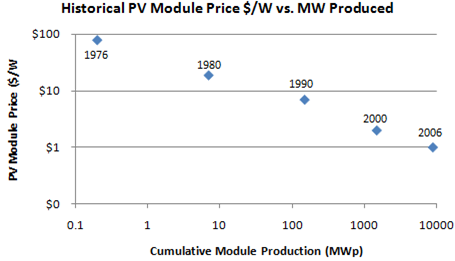
Problems with the Grid
The existing grid has a number of problems, among them:
- The wide area grid is susceptible to cascading failures - The energy grid has been developed with extensive interconnections and grids often spanning continents. The purpose of this interconnection is to improve reliability through redundancy, yet in fact increases the risk of wide area failures because any imbalance can be propagated quickly over an ever widening area.
- Grid stability cannot be maintained with >30% penetration of renewables – Although many regions are mandating 20-30% of renewable energy, many experts believe that voltage/frequency stability cannot be maintained at such levels if predominately variable wind and solar generation.
- Grid capacity is saturated in many locations and requires additional transmission lines – The cost and environmental impact of new transmission lines is considerable, yet still is planned as the only alternative in locations from California to Texas. However, these new lines only defer the stability and reliability problems.For grid reliability, transmission assets are sometimes deployed in duplicate, then used at low capacity in case of failure – the planned under-utilization of expensive assets is wasteful. Alternative pathways to assure reliability should use redundancy such as is commonplace in the internet, and does not require under utilized assets.
- Wide-area grid topography results in inefficient energy flows by routing around mountains and lakes – energy flows across the grid according to Ohm’s law, and often takes undesirable detours due to geographic features, wasting transmission capacity. Energy flows cannot be identified or traced - Energy flows into and out of the grid at millions of points, and there is no tracing of the energy. This makes it impossible for a user to ascertain that they are in fact using green energy. This also makes it difficult to allocate expenses for transmission appropriately.
Today's energy grid has been developed with extensive interconnections of grids which span continents. The purpose of this interconnection is to improve reliability through redundancy. However, in some ways, this interconnection increases the risk of wide area failures because any imbalance can be propagated quickly over an ever widening area.
The satellite photo depicts the grid failure in the Northeast in 2003, which affected 50 million people, and illustrated by the large black section stretching from Ohio to New York. This blackout began with the failure of a single transmission line, and quickly spread across the region.
Large synchronized electrical systems are susceptible to large-scale failure. Variable power generation such as PV and wind can cause the same fluctuations which lead to failures. As the penetration of wind and solar increases, the grid will become increasingly susceptible to the same type of cascading failure. The power industry is becoming increasingly concerned about these issues. Three articles in the current Sept/Oct 2010 issue of IEEE Power and Energy address the issues of dealing with variable renewable energy on the grid. The Digital Grid restricts any failure to the original cell and prevents cascading failures.
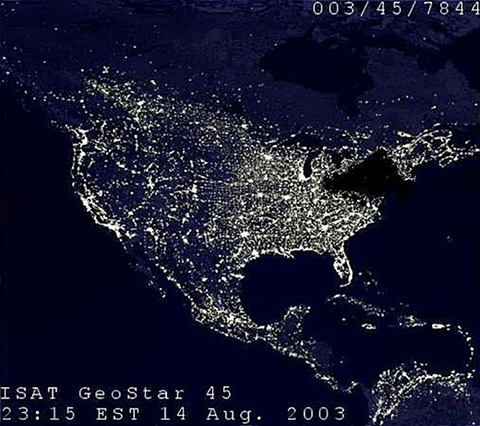
Many states in the United States have set goals of from 10% to 30% renewable energy. Europe has set a target of 20% of energy to be produced by renewable sources. Japan has set a target of 53 GW photovoltaic (PV) generation by 2030 , more than 25% of peak demand. In the UK, it is projected that $10-$12 billion investment in grid infrastructure will be necessary to connect the planned 40 GW of wind generation by 2020.
The map, produced by the National Renewable Energy Resources Lab of US DOE, shows the potential wind resources available in the US. Since the wind energy availability does not match population centers, where energy is consumed, an extensive new set of transmission lines, shown as green lines on the chart, has been proposed.
Our proposal with the Digital Grid is to segment the grid, and use energy storage within each cell of the grid to become energy independent, with only occasional energy transfers between cells.
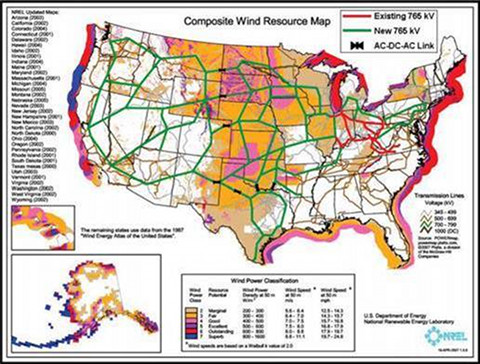
As pointed out by Eric Lerner*, electric power does not travel by the shortest route from source to sink, but also by parallel paths through other parts of the system (right above) . When the grid stretches around large geographical features, such as mountains, rivers and lakes, loop flows around the obstacle are set up that can drive as much as 1 GW of power in a circle, taking up transmission line capacity without delivering power to consumers (right below).
The first example wastes energy and the second wastes transmission capacity. The Digital Grid eliminates these effects by providing for controlled flows of energy.
"What's Wrong with the Grid?", Eric J. Lerner, The Industrial Physicist, Oct/Nov. 2003
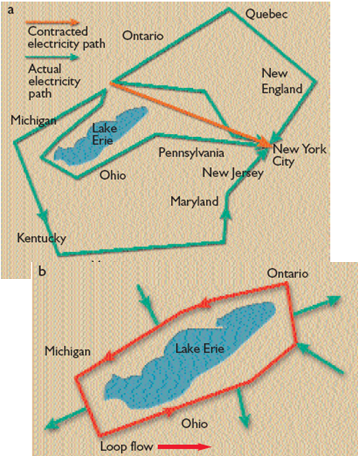
The Digital Grid solution to these transmission grid control issues is to segment the grid into substantially self-sustaining regions or “cells”, then control the flow of energy between those cells using controlled, scheduled energy flows.
This segmentation can be done gradually, and the existing transmission lines can be used, therefore, making the cost no greater than current plans for upgrading the grid but without the need for costly new HVDC lines.
Any failure on the digital grid cannot spread outside the originating cell, improving the total grid reliability.
The map illustrates this concept compared to Japan where three such cells have already been implemented on the nationwide grid. In Japan the cells were created due to the need to bridge the gap between islands and to integrate regions using different frequencies, though the same result of grid reliability has been achieved.
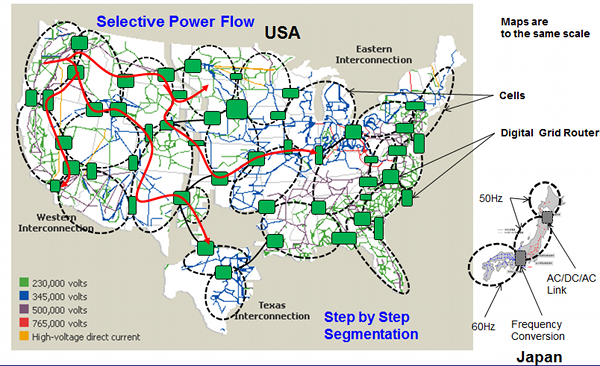
Technology
To address the issues of the grid, a new Digital Grid system is proposed where a wide-area synchronized grid is subdivided into small or medium sized cells, and connected through asynchronous and coordinated control power exchanges.
Asynchronous coordination is the exchange of power through connecting separate unsynchronized AC sub-grids using multi-leg AC/DC/AC conversion via power semiconductors (IGBT) with accompanying communication. These devices we call "Digital Grid Routers" (DGR).
The Digital Grid can be described as this:
- Independent cells with mutually unsynchronized phases and frequencies are connected using DGRs composed of power converters and coordinated transmission lines, which exchange electric energy between selected cells by supplying specified energy directly through power converters to the designated end point defined by an address
- In each synchronized system within a cell, power equipment control devices called digital grid controllers (DGCs) are used to transfer information and thereby to control power equipment such as generators and energy storage devices
- Each DGR and DGC has a CPU, memory and network communications, and are assigned unique IP addresses and communicate using an IP protocol like on the Internet
- For communications, the power transmission line can be used so as to integrate power and information on a single line, or an external data network may also be used
- A DGR may have two types of leg: either with power conversion or without power conversion. Each point-to-point connection is composed of a set of legs, one with power conversion and the other without. This avoids the undesirable and unnecessary double conversion of power.
However, the Digital Grid supports smaller segments, and has addressable exchange of energy between cells which are not directly connected. The digital grid is a new architecture for the grid, not a single point solution like Tres-Amigas. In order to enable very high penetration of renewables, each cell must be made substantially self sustaining, with pre-planned injections of energy to meet forecast shortfalls. This next stage of diffusion of the Digital Grid will require energy storage.
If each cell has suitable energy storage, it is freed from the conventional restriction of exactly matching generated power with demand each second. With the existing grid, the value of energy is inherently tied to the time it is produced as well as the time it is required, which is the time-related value of electric power.
Our Digital Grid removes this time-related value of energy, and enables true commodity pricing of energy.
The Digital Grid Routers
- are Computer Controlled Multi-Leg AC/DC/AC converters with Internet communications
- are Computer controlled, like network routers
- are Addressable from anywhere on the grid, like network routers
- connect multiple sub-grid cells through existing AC lines, where each sub-grid cell is synchronized internally but not synchronized with other cells
- exchange energy with other cells on a pre-planned self-coordinating basis
- can support frequency regulation from cell to cell
- uses IGBT devices for AC/DC and DC/AC conversion
- have multiple “legs” for connection to multiple external cells
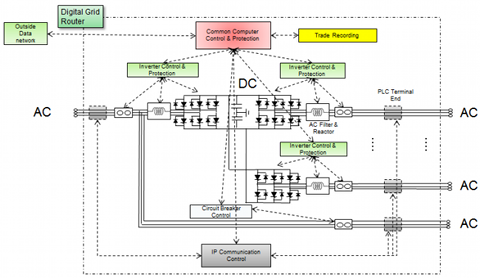
Digital Grid Controllers (DGC) are distributed, intelligent and network addressable devices which are associated with each active grid element, such as generators or storage devices. DGCs make energy transfer requests, initiate and terminate energy transfers, implement the energy transfer protocol, and provide autonomous operation for each active element within a cell.
The diagram below shows a group of autonomous cells, each with multiple Digital Grid Controllers, and linked to the other cells via Digital Grid Routers.
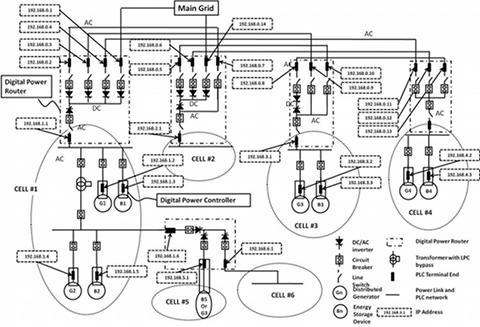
The digital grid transmits discrete energy flows from the source cell to the target cell, possibly being routed through intermediate “digital grid routers”. One important aspect of the digital grid is that power and information are transmitted together, thereby making a more robust architecture. The information encoded with the power identifies unambiguously the source and destination among other key data.

The illustration shows four cells, each connected with digital grid routers and transmission lines. Each transmission lines is point-to-point. This illustration shows two possible routes for the power exchange. The green line shows the direct path from Cell #1 to #3, and the red line shows an alternate route from cell #1 to #2 and finally to #3.
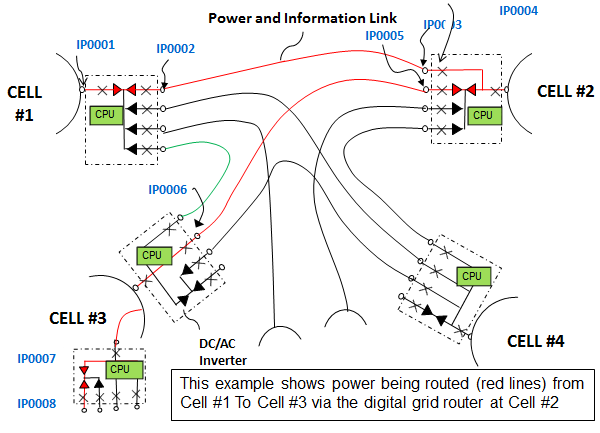
Here is an example of one cell requesting a power exchange, to be supplied by the successful bidder.
First, a power request is broadcast. The power request includes bid information such as the amount of power (kWh), when it is requested, the desired price, and any other qualification such as green certification. Any other cells who wish to supply power under the broadcast conditions responds to the requesting cell. The original requesting cell selects the best offer, using its own criteria, and sends an acceptance response to the selected bidder. At the appointed time, the power is transfered to the requesting cell. A unique attribute of the digital grid is that the transmitted power is tagged with the information about the transaction, including source, destination, and any green credits or other meta data.
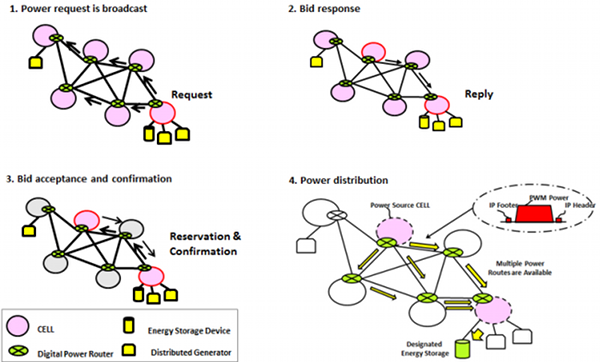
Energy transactions between DGRs and/or DGCs are initiated through requests from others. Each DGR and DGC operates autonomously based on their local policy, algorithms and rules, initiating the power transfers as needed.
Energy flows are monitored by built-in metering devices and recorded together with reservation information, including time, seller, buyer, price, energy source, energy amount, etc. These records are retained in a database like a bankbook for ordinary financial transactions. This enables the unambiguous confirmation of green energy use, carbon credits and third party supply of energy.

Benefits
The Digital Grid offers many benefits, to the wide-area grid, to society and on down to the individual consumer. The table summarizes the major benefits, with details provided in the segments below.
| Function | Benefit |
|---|---|
| Segment the Grid | Robust against failure |
| Gradual conversion from conventional grid | Any community, municipality or region can map a strategy for sustainability |
| Uses existing transmission lines | Increases total grid capacity without additional transmission lines |
| Creates a path to sustainable 100% renewable energy | Addresses climate change along with growth in population and energy use |
| Storage of energy removes unnatural mismatch of supply-demand pricing for energy | Enables true commodity pricing for energy |
| Tagging of energy flows enables unambiguous tracking of energy source | Carbon trading and green accreditation is secure when the provenance is verifiable |
| Safety | Power on any digital grid line is not transmitted without a positive confirmation from the receiver |
The most immediate benefit to the Digital Grid is grid stability and redundancy. Power can be acquired using other paths if some lines have faults because a number of paths are available among cells, therefore it is not limited to the primary path and backup path. Theoretically, N cells have the order of N2 connecting paths. This makes the wide area grid robust against major failure.
This robustness is similar to the stability and redundancy of the Internet.
The DGR enables the delivery of electricity to the destination cell using an address and routing.·The energy is tagged with identification information including generation source, route of delivery, storage device (if any) and end-user (energy consumer).
The digital grid dramatically improves the value of energy storage and makes it possible to have a business platform for a new energy trading business. Free market commodity trading mechanisms can be applied for electricity trading which will accelerate investment in such new systems
In the grid today, energy must be generated at the instant that it is consumed. There are tremendous inefficiencies that result from this requirement. For example, generators are frequently operated at lower than optimal output level so as to be available when power demand rises. The efficiency of the power plant at these lower operational levels is lower meaning the cost of energy is inflated as well as the output of harmful emissions. Fluctuations in output levels is also a maintenance issue, increasing the cost of maintenance of some power generation equipment.
We call this effect the "time value of energy", where the value of the energy varies dramatically depending on the time of day or season. When energy storage is used, the restriction that energy must be produced and consumed at the same time is removed. Storage enables flexible commercial trading so energy can be reserved for future use, and the time of delivery can be selected based on congestion rules or other factors.
Storage also enables lower volatility in the price of energy, which creates a stable market and thereby encourages new investment in energy infrastructure.
In developing nations, there are often isolated grids in each city, which are not connected together because of low density demand. Since cells in the digital grid are not required to be synchronized, the Digital Grid Routers can be used to inexpensively connect these isolated grids without requiring synchronization. This will provide more energy sharing across developing countries, and higher reliability through interconnection.
The digital grid technology can be extended down to the level of the end user, either a home or a commercial user. A digital grid enabled home can be envisioned. Since power is never delivered to the device without the handshake power protocol, safety is dramatically increased. With smart appliances in the home, and smart power delivery, a ground fault can be detected and power cut off in nanoseconds, much faster than existing circuit breakers. This will improve fire and accident safety.
With safety assured, new high power appliances and applications can be utilized. If the energy is from a renewable source, the home equipped with the digital grid can use energy in ways that are unthinkable today.
High power tankless water heaters, high power whole-body driers, fast-temperature changing induction cooking range are some of the applications which can be readily forecast.
However, if energy is abundant, there are new horizons in applications which will be invented, even as new industries have been founded on the Internet and information revolution.
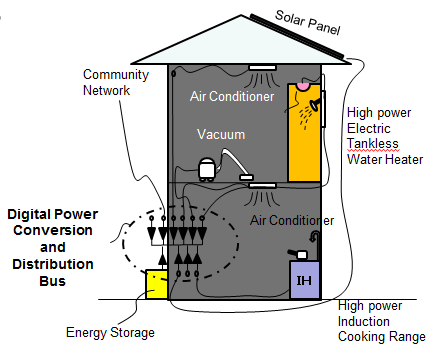
Feasibility
For any technology which proposes a radical rethinking of the architecture of infrastructure so pervasive and critical as the electrical grid, the challenge is to not only prove it is possible, but moreso to prove that it is feasible. We discuss three aspects of feasibility:
- Is it technically feasible, meaning have these technologies been commercially proven at large scale and in the harsh environments typical for electrical grid infrastructure?
- Is it economically feasible, meaning can it be deployed at the same cost or lower cost than the existing technology?
- Can it be effectively deployed incrementally so that a wholesale change is not required?